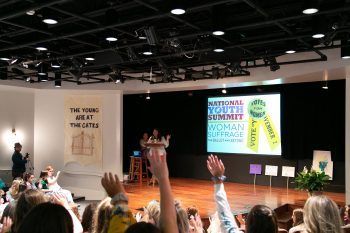
A group of 68 students from local middle and high schools were transported to the past when they arrived in downtown Jonesborough on May 21. Walking through a crowd of mock protesters, costumes complete with historically accurate replicas of century-old protest signs, the students started their day learning about women’s suffrage at the International Storytelling Center.
Women earned the right to vote in the United States exactly 100 years ago. But the implications of that historic event ripple through the present day, and extend into the far future. Along with ten other Smithsonian Affiliate institutions across the nation, ISC was a regional sponsor of the National Youth Summit, an annual event produced with the National Museum of American History. The theme this year was women’s suffrage.
The event was the latest example of ISC’s deepening commitment to quality programming for young people, especially in our home region of Northeast Tennessee.
Many people don’t realize that it was the state of Tennessee’s “yes” vote that ratified the 19th amendment. That proud moment capped what had been a difficult 72-year struggle for the women’s suffrage movement, when organizers fought opposition from powerful enemies with intriguing names like the whiskey ring, the railroad trust, and the manufacturers’ lobby.
The day’s programming included an interactive panel of local leaders, all women, who are active in community and government organizations, and a performance of “Things Are Changing,” a live piece from local playwright Anne G’Fellers-Mason, that helped students understand the political and social landscape of the region during the fight for women’s suffrage. The piece, which G’Fellers-Mason wrote from archival newspaper clippings in local papers, focused on Julia Bullard Nelson, a leader of the movement who made her home in Jonesborough. The play included an audience-participation segment—one of many interactive elements built into the programming to help bring the past to life.
One of the day’s highlights was a livestreamed event produced by the National Museum of American History Students that allowed students to interact in real time with 4,500 other students across the nation as well as a Washington, D.C. panel of prominent speakers. Designed to connect attendees to other National Youth Summit Sites across the country, the D.C. panel included 12-year-old activist Naomi Wadler and American labor leader and activist Dolores Huerta. Founded in 2011, the National Youth Summit is a program designed to brings students together in a nationwide conversation with educators, policy experts, and activists. It chooses a different area of focus each year, and all activities are designed to connect to Common Core Standards.
The International Storytelling Center organized a special postcard station complete with historical relics, where students were asked to get creative with their own postcard designs. One of the goals was to encourage kids to engage in the political process even before they’re old enough to vote. They wrote and mailed messages to real government representatives at the local, state, and federal levels to talk about the issues that were most important to them, connecting the historical suffrage movement to political issues that are important to people today. Some of the topics they were inspired to write about were gun control, mental health, and climate change.
One of the most heartfelt stories of the day was a taped interview with 97-year-old Louise Crowe, a local activist who reminisced about the first time her mother exercised her right to vote. Our student participants gave the video a standing O.
ISC’s goal was to inspire young people to feel more connected to today’s political conversation by showing how dedicated activists worked together successfully for transformative change in the past. The discussion included some of the problematic aspects of the movement, including racism, highlighting complexity alongside the more traditional narrative of collaboration and triumph. In exploring these important stories in a safe and inclusive way, where people from different background can listen to stories and find common ground, we’re helping to build a better future.
To learn more about ISC’s recent youth initiatives, head over to the ISC website.
—–
Stories in Motion is a regular feature in which ISC examines the fresh ways we see the power of storytelling at work in the world.

